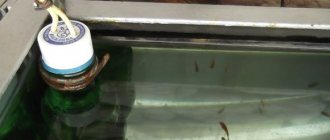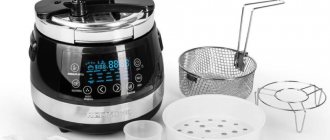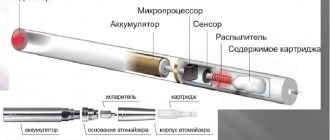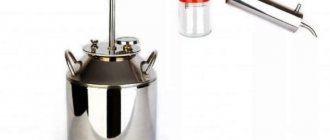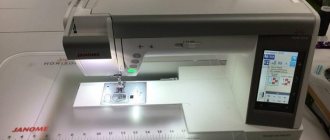Aquarium thermostats
These are devices with a built-in thermostat. You set the required water temperature, and the device heats it up to the required numbers. After this, it automatically turns off, turning on after the medium begins to cool.
There are 2 types of such water heating devices.
- Mechanical.
- Electronic.
Important! Mechanical devices are less accurate (the error is from 1 to 2 degrees), but have a lower cost. Electronic devices are much more accurate, but their cost is much higher.
Most devices come without a built-in thermometer. The device maintains the optimal temperature, but does not display its value. Therefore, you need to purchase a special thermometer for water along with the thermostat.
When choosing an aquarium water heater, you need to pay attention to the following characteristics:
- Correct selection of power.
- The presence of thermoregulation.
Important! It is believed that a 10 W device is enough to heat 4.5 liters of water. For an artificial reservoir of larger volume, it is better to buy not one powerful device, but several low-power ones: this way it is easier to heat the water to optimal levels.
Advantages
Modern models of water heating devices have the following advantages:
- Reliability.
- Possibility of placement under water.
- Safety.
Important! During prolonged use, the device may produce errors, so it must be checked periodically using a regular thermometer.
Now about which water heater for an aquarium is better. If you are using shallow soil, it is advisable to use a thermal cable heater. In this case, you not only maintain the necessary environmental characteristics, but also create better conditions for aquatic plants. In addition, heated water freely rises to the surface without stagnating in the ground.
Heater power
When choosing the power of the device, you need to rely on the instructions for use. Immediately tell the salesperson in the store what the displacement of your aquarium is. The degree of water heating depends on the power.
There is a golden rule for calculating power, according to which there is 1 liter per 1 W of power. water. Some manufacturers indicate other parameters, so you should still check the instructions.
Table for selecting the power of the heating system by tank volume:
| Power, W | Tank volume, liters |
| 25 | 10-25 |
| 50 | 30-50 |
| 75 | 45-75 |
| 100 | 60-100 |
| 150 | 90-150 |
| 200 | 130-200 |
| 300 | 230-300 |
How to properly install a heater in an aquarium?
Depending on the installation method, there are 2 types of aquarium water heaters:
- Non-submersible. These models go down to a certain point. The upper part of the device is above the surface.
Important! The disadvantage of non-submersible devices is their short service life.
- Submersible. Such devices have a longer service life because they are completely submerged in water.
How to properly install a heater in an aquarium?
- The device cannot be installed close to the surface, since during evaporation its upper part may be exposed to air, which leads to failure of the heater.
- Do not install the tube at the bottom of the aquarium. The minimum distance from the bottom is 20 mm.
- The tube is installed near the oxygen filter. Air emissions contribute to uniform heating of the water mass throughout the aquarium.
- After the device is installed, you cannot immediately connect it to the network. Keep the time for about half an hour. In this case, the temperature of the heater and the medium will be equal.
Important! If you do not wait this time, the glass may crack. If you want to clean the aquarium, the device must be turned off.
Optimal parameters
When talking about what temperature the aquarium water should be, the species of the pets is taken into account. For example, the warm-water tropical species Siamese betta needs high-quality water heated to 26 - 28°C. Cold-water species are less demanding of living conditions. Neons in cool water (20 – 22°C) increase their life expectancy. This must be taken into account when forming a group of inhabitants of a common aquarium.
A universal indicator suitable for all aquarium species is 25°C. This temperature can be set in a home aquarium with many different species, and there will be no mistake.
Types of water heaters
Some novice aquarists believe that a water heater is not the most important thing. But they are very wrong. Many fish in their natural environment live in tropical and warm rivers.
This suggests that the natural water temperature for them is 26-27°C. If in the summer the fish somehow survive the lack of additional heating, then in the winter this could be a disaster for them.
Although summer is not yet an indicator, since the water temperature changes day and night and not every fish will survive these changes (even 2-4 degrees). Also, water can be affected by leaving a window open for a long time or suddenly turning off the heating in the apartment.
Think carefully before deciding not to purchase a heater, because you need to be 100% sure that the water is as warm as the fish need it. By the way, modern heaters have temperature sensors that control that the water does not overheat.
Water heaters come in different types. We will tell you about each of them below. You will choose the one that suits you best.
Submersible
How immersion heaters are used is already clear from their name. Such a water heater is lowered into the water to a certain mark on it. It looks like a cone or an oblong cylinder, inside of which there is a heating element. Its body must be heat-resistant and strong.
This device is made of different materials, it can be glass, plastic, titanium.
Flow-through
Such heaters are installed outside the tank, cutting into the filter hose. This ensures uniform heating of water. This device has a plastic body.
Its external placement, in addition, makes it possible to save on free space inside an artificial reservoir. True, it is recommended to use it in large aquariums, since there are no such water heaters with a power of less than 200 W.
Such heaters are installed under the ground, allowing the entire tank to be heated evenly. They also have a good effect on plant development.
This heater does not take up much space and is not visible under a layer of soil. True, if you want to remove it, you will have to disrupt the entire atmosphere of the artificial reservoir.
Cable heaters are more common in terrarium farming, but are also used for home aquariums.
Heating mats
These rectangular mats are placed under the bottom of the tank, through which the heat spreads evenly throughout the aquarium. It is believed that such heaters also have a beneficial effect on plants.
Naturally, you won’t be able to remove this water heater without lifting the glass house itself. But it will serve you much longer than other similar devices.
Popular manufacturers
In specialized stores you can find heaters from different manufacturers. Review of the most popular ones:
- Devices from Juwel have a built-in thermostat for the aquarium. There are several types that differ in power. The mount is standard, which allows it to be used for different containers.
- Tetra heaters also have a water heating regulator. The double heating element is placed in a sealed container with a lid. Thanks to this, it can be immersed in water. Suitable for large aquariums. Heat distribution occurs evenly. Attaches with suction cups.
- The Aquael heater is a compact device. Can be attached in any position. Located on glass. The device has built-in overheating protection. Thanks to this, it does not burn the small inhabitants of the reservoir.
With your own hands
When deciding to make a water heater for an aquarium with your own hands, you need to take into account the risk of electric shock during its operation. Although many are able to make safe aquarium heaters.
For production you will need:
- resistance resistors;
- a piece of tube with thick walls;
- dry filler;
- durable thermostat.
Manufacturing scheme:
- The number of identical resistors to generate suitable power is calculated.
- The size of the glass tube is determined (depending on the number of resistors). You should leave approximately 15 cm of free space in the tube.
- Dry filler is selected. Cleaned and calcined sand is suitable.
- The bottom of the tube is coated with sealant (for insulation), and then closed with a rubber stopper.
- A power wire connected to the thermostat is soldered to the upper and lower resistors.
- The heater is placed vertically inside so that the top of the tube does not show out of the water. The device must be secured to the walls of the vessel using suction cups.
You can also make a water heater yourself, following our step-by-step instructions. But remember to be extremely careful, because you risk getting an electric shock!
To create the device you will need resistors, a piece of glass tube with thick walls, dry filler, and a remote thermostat.
Difference between water temperatures in the aquarium and in the room (°C)
- Calculate the current by dividing the power by the applied voltage. This way you will understand the resistance value of the heater. Select the required number of identical resistors (their total power and resistance indicators must correspond to the calculated values).
- Determine the length and diameter of the glass tube based on the size and number of resistances. Please note that resistors soldered in series must be placed in a tube with a free space of 15 cm.
- You can use purified and calcined sand as a filler.
- Close the bottom hole of the tube with a rubber stopper placed on the aquarium sealant.
- Solder the ends of the network cable to the upper and lower resistors. Place all this in a tube and cover it with sand (it should be at the bottom of the tube, covering the top resistor).
- Seal the top of the tube with aquarium sealant. Connect the power cable to a thermostat with a remote temperature sensor, which is lowered into the tank.
And you already know how to attach the device. We talked about this a little earlier.
When setting up a home aquarium, you will need many components. After all, in order for the inhabitants of an artificial reservoir to feel good and comfortable, everything needs to be done wisely. One desirable tank component is a water heater.
In this article we will talk about why it is needed, find out what these heaters are, and figure out how to use such a device.
In addition, a bonus for you will be detailed instructions on how to make a heater with your own hands, while saving money and learning something new.
Video of making a homemade heater
For artificial reservoirs, you can use not only devices from manufacturers, but also make an aquarium heater with your own hands. The assembly sequence can be seen in the video.
Special devices for the aquarium are designed to make life comfortable for fish and easy for owners. This also applies to the water heater. Once you install the device, you don’t have to worry about temperature fluctuations that will harm small pets. When choosing a heater, you must rely on a number of indicators described above, and on your own preferences.
If you liked the article, leave comments and share a link to it on social networks.
Aquarium heater with thermostat
If the aquarium contains tropical fish, the water temperature should be an order of magnitude higher than the air temperature in the room. To maintain uniform water temperature during the day and night, aquarium heaters with a special thermostat are installed. The latter is equipped with a sensor. It heats the water to the set temperature, after which it turns off the heating element. When the water temperature begins to drop, the thermostat turns the device back on.
The thermostat allows you to maintain a certain microclimate, and aquarists do not have to worry that their pets will die due to hypothermia or overheating of the water.
There are two types of thermostats:
- Mechanical. It has a relatively low cost. Displays temperature readings with an accuracy of plus or minus 2 degrees.
- Electronic. An order of magnitude more expensive than a mechanical one. Shows the water temperature in the aquarium with high accuracy.
Thermostats are also divided into:
- Built-in. Together with the heating element they are located in a sealed housing, which is installed directly into the aquatic environment.
- Remote. Installed outside the aquarium. They are connected using a wire to a temperature sensor located in the aquarium.
Which heater manufacturer to choose
I recommend purchasing heaters from well-known manufacturers that have long proven themselves in the aquarium equipment market, such as: Aquael, Tetra, Eheim, Sera, Fluval, Ferplast.
ADVICE
To avoid overheating the water in the aquarium, it makes sense to use two heaters of lower power instead of one. True, this option is bad at a price that will be twice as high. But you will always have a spare heater on hand in case one of the two fails.
ATTENTION !
Never, under any circumstances, turn on your aquarium heater without completely immersing it in water. Failure to comply with this requirement will lead to failure of the device and waste of money spent. Also, do not forget to turn off the heater when cleaning the aquarium.
Installation
To maintain the desired microclimate in the aquatic environment, you need to know how to install a heater in an aquarium. The water heater can be installed in both horizontal and vertical positions. When installed vertically, the adjustment handle should be located above the water level. When positioned horizontally, the heater is completely immersed in the aquatic environment.
The body of the heater is usually marked with water immersion level marks. The appliance must be installed so that the water is above the minimum immersion level. Over time, water evaporates, so you need to ensure that it does not fall below the minimum level.
The heater must not be installed in gravel or sand.
A bracket is installed under the heater head, which is attached to the wall of the aquarium using suction cups.
Please note that the installed device can only be turned on after 15-20 minutes. During this time, the temperature of the heater will become equal to the temperature of the water in the artificial reservoir. Only after this the device is connected to the network.
Top 3 best aquarium heater models
There are the most optimal heaters, which are often used by aquarists to increase the water temperature:
- Barbus Heater 009 50 W . The average price is 300 rubles. Manufactured by a Russian brand. Has a power of up to 300 W. For small aquariums, it is recommended to buy a 50 W unit. The elements are double insulated inside to prevent sudden breakdown or short circuit. The product with a metal case is equipped with a dial. Temperature adjustment is carried out within 20-32 degrees.
- Tetra HT . Approximate price 1300 rub. The device is completely submersible under water. Has precise thermoregulation. Designed for large aquariums of 150-250 liters. Power is 150 W. The temperature is maintained within 19-32 degrees. It is often used for fish that like warm environments.
- Hydor External Aquarium Heater ETH 200-12 . Approximate price 4200 rub. The model is intended for experienced aquarists. Used for breeding large numbers of fish that require precise temperature control. It is maintained within 18-34 degrees. The power is 200 W, which is enough for a 200 liter aquarium.
Why do you need an aquarium heater?
When heating an aquarium, some keepers make a fatal mistake: they judge the water temperature by using a thermometer located next to the lamps. Those, in turn, are able to raise the temperature in the upper layers by several degrees. The main rule of heating in an aquarium is: the temperature should be the same throughout the entire thickness. If the readings differ depending on the time of day or the measuring point by more than 2°C, it is necessary to install one or more heaters for the aquarium, and, if possible, improve water circulation, which is especially important for reservoirs with large displacement. Temperature fluctuations negatively affect the well-being of fish and significantly reduce their life expectancy. To control and maintain stable temperature indicators, special sensors can be used that program the device to work or rest in a fully automatic mode. By the way, in the summer, such a heater may hardly turn on - the latest generation models with thermostats demonstrate high efficiency with economical energy consumption. Please note that seawater reservoirs place special demands on the body of the device - it is recommended to install an aquarium heater with corrosion protection in them. For devices that do not have an indicator of the current temperature, it is recommended to additionally purchase aquarium thermometers to help quickly determine the temperature. In addition, with a long service life, some heaters begin to “fib” about the temperature - and a cheap thermometer will cost less than a thermostat. The newest models are equipped with thermal protection against overheating - if some of the water evaporates or the device is placed too high, they will turn off on their own.
Popular sections:
Aquariums Sale of kittens and puppies Terrariums Products for cats Products for dogs
To uniformly heat large aquariums, in particular those inhabited by fish from stagnant bodies of water, it would be wise to purchase several small heaters or a flow-through heater. If you can get numb in your apartment while waiting for the heating season, it is better to buy a device with a power reserve so that intense heat exchange does not lead to a decrease in water temperature. Under normal conditions, a simple formula is used to select a heater: 10 W of power for every 5 liters of aquarium volume.
Cable-type thermostats, in addition to their main functions, stimulate plant growth and prevent bacterial stagnation in the soil.
What to look for when buying an aquarium heater
1. Can be used in salt water if you are the owner of a marine aquarium. The fact is that salt can corrode some materials.
2. Equipment. Most heaters come with suction cups to secure them to the aquarium, but they may not! This is worth paying attention to.
3. Functions. Some heaters are equipped with an additional emergency shutdown function in case of breakdown. This feature is an additional pleasant, but not superfluous, addition to the purchase.
4. Power and presence of a thermostat. Well, I won’t explain anything about these selection criteria, as everything has already been described in some detail above.
How to properly install a heater: a step-by-step guide
There is no problem in installing a water heater correctly - it is perhaps the easiest device to install for an aquarium, except for a thermometer.
⚫ Checking network requirements. Before installing an aquarium heater, read the instructions and its technical approval. Standard models are powered by AC power and do not require the installation of adapters. An important condition when carrying out any manipulations with the heater is to disconnect it from the power supply. It is strictly prohibited to turn on the device if it is not completely immersed in water. Remember about safety precautions: if you have the slightest suspicion that a heater or other electrical appliance is malfunctioning, do not put your hand in the water until you turn it off. Any damage to the wire is grounds for replacing the device with a new one. It is not recommended to carry out even minor repairs to heating equipment for an aquarium, otherwise the fish can just as easily be released into the bathtub with a hairdryer turned on. ⚫ Pre-installation. Attach the supplied suction cups to the bracket. Screw the bracket over the top end of the heater or insert the flask into it, depending on the configuration of the fastener. That's all!
⚫ Immersion of the device. The minimum water level provided for placing the heater is usually indicated on the body using a special mark under the adjustment handle. Remember that the higher the temperature of the water, the faster it evaporates and the more often it needs to be topped up. Otherwise, the heater may be above the water level, which is prohibited by the user manual. Immersing the device to a depth of more than 80 cm is also not recommended - more accurate information about each model is contained in the instructions for it.
The design features of the device allow it to be placed not only vertically, but also horizontally in order to disguise it or effectively use the area of the side walls. Never bury the heater in sand or fine gravel! Do not place the device in the “dead” zone of the aquarium, where there is no water circulation - in this case, its actual benefit will be reduced several times.
⚫ Temperature equalization. Before turning on the device, leave it in water for 15 minutes so that the body reaches the same temperature as the environment.
⚫ Turn on. Insert the plug into the socket and wait until the indicator reaches the required level. Check the thermometer readings with the desired temperature several times to ensure that the device is not defective.
In our store you can buy
thermostats heaters thermostats
